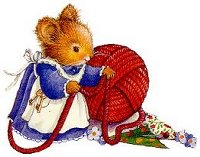
Basic
Sewing Tips...
This page contains tips related to basic sewing and also some
helpful ideas. If YOU have a tip that belongs here just
email me and let me know! I'd love to add YOUR
name to our growing list of sewing friends!

Here are some good basic sewing tips to get you started sewing... These
are just some simple guidelines. As you become more familiar
with sewing it will become much easier and your skill
level will quickly increase.
![]()
Basic Sewing Tips...
Submitted by: Sara
If you're new to sewing or are wanting to teach a child to sew, a really great way to get in some practice is to use simple children's coloring books. Remove the thread from your machine and practice following the simple curves and angles of your chosen printed page. This allows you to get used to how the machine turns, pivots, and how to go around corners without wasting any of your fabric.
(Thanks Sara!)
Problem Solving...
Many times even experienced seamstresses can have problems getting their sewing machines to run smoothly. One of the #1 problems is often the needle. A needle that is bent, burred, dull or simply the wrong size or type can cause problems with the stitch quality or even cause the fabric to snag, jam or pull. Just because you can't see the damage to the needle, doesn't mean there isn't any! Always start a new project with a fresh needle. Typically the more delicate and finer the cloth, the smaller the needle size. The needle is also one of the few things to actually come into contact with your fabric, so err on the side of caution and change that needle!
The Basics...
- Before sewing, pre-treat fabrics to the manner to which
they'll be handled. Such as: drycleaning,
washing machine, etc. - Read all pattern directions BEFORE
cutting out any fabric. - If something in the directions doesn't immediately make
sense read it over again 3 times - slowly. - If still in doubt about how to sew something together,
pin it first to give you the idea. This is much easier
than ripping out those stitches later! - Make sure your fabric is laid out properly before making
ANY cuts in the fabric! This would also mean double
checking to make sure the pattern piece is on a fold
line if need be. Some pattern pieces require that
you have the pattern face up-side down.
Make sure you double check. - If you can't lay out the whole pattern at one time
cut out the largest pattern pieces first so if you later
make a mistake and don't have enough fabric left,
it will be a smaller (and cheaper to replace)
piece of fabric. - Buy a good basic sewing book to refer to when you have questions.
This is an invaluable tool for a new seamstress. - Circle the pattern # and size that you are making. Also,
check the layout guide to ensure that you're using
the proper one and then circle it so there will be
no mistakes, especially for multi-sized patterns. - Always start out with a fresh needle and a clean, and
oiled (if your machine requires oil) machine. - Try and buy all thread, buttons, interfacing, bobbins,
needles, etc. all at the same time so you'll be sure
of a good color match and of having all your
supplies handy when you're ready to sew. - Use good lighting when you sew to avoid eye strain.
Magnetized seam guides are great for this, as well.
Check with your machine manufacturer, if your
machine is computerized, to be sure the
magnetic strip is safe to use on your
machine. Most are. - If making clothing for children it's a good idea
to use safety pins for their fittings. This will keep
your chilren more sewer-friendly and avoid the
struggles with getting them to try on an
outfit for size. - Keep your pattern envelope (picture side out) and
used pattern pieces in a zip-lock baggie. This will
keep your things neatly organized and you can
tell at a glance which pattern it holds. - As your sewing skills improve you'll find that there are
many different ways of doing the same thing. These are
not "wrong", just different methods. Experiment, then
choose the one that works best for you. - Practice, practice, practice! You'll be feeling more
confident in no time. Start with small, easy projects
that can be finished quickly. Perhaps a stocking to
hang by the fireplace, a small pillow, or eye-glass
case. Hang on to your first sewing project, too.
You'll be amazed at how quickly your sewing
skills will improve!
Back to Sewing Tips...
...other sewists have been here since 10/11/99!
Please take a moment to sign my guestbook to let
me know that YOU were here. Thanks! =)